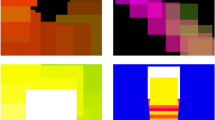Abstract
We have found a new computer solution to the aesthetic field equations. This solution describes a two-particle system with more structure than previously found. The contour lines show an arm structure. We have observed four arms around the maximum center. The location of the maximum (minimum) center is not along a straight line as a function of time. This is the first time that such an effect has been observed for any kind of nonlinear partial differential equation, so far as we know. A further discussion of the aesthetic principles leading to the field equations is given.
Similar content being viewed by others
References
M. Muraskin,Ann. Phys. (N.Y.)59, 27 (1970).
M. Muraskin,Int. J. Theor. Phys. 8, 93 (1973).
M. Muraskin and B. Ring,Found. Phys. 4(3), 395 (1974).
M. Muraskin,Int. J. Theor. Phys. 7, 213 (1973).
M. Muraskin,Int. J. Theor. Phys. 6, 37 (1972).
N. Zabusky and M. Kruskal,Phys. Rev. Lett. 15, 240 (1965).
Author information
Authors and Affiliations
Additional information
Work supported in part by the U.S. Atomic Energy Commission.
Rights and permissions
About this article
Cite this article
Muraskin, M., Ring, B. A two-particle collision in aesthetic field theory. Found Phys 5, 513–523 (1975). https://doi.org/10.1007/BF00708893
Received:
Issue Date:
DOI: https://doi.org/10.1007/BF00708893




